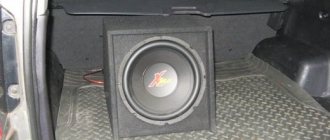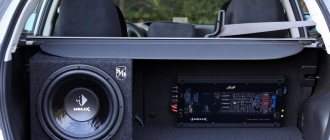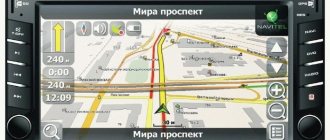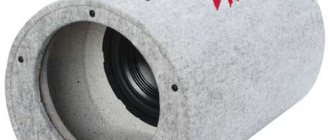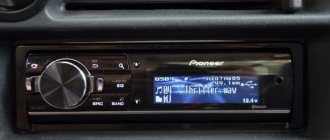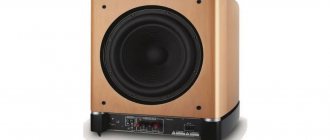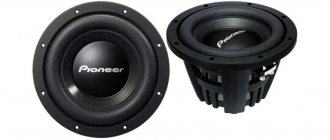Articles
How to connect a supra subwoofer
Many people wonder how to connect a supra subwoofer. After all, by performing such a process on your own, you can save a lot of money that will be invested in the car in the future. Why pay someone to do something you can do yourself? But let's take things in order. The supra srd t30a subwoofer is connected according to the instructions.
Passive and active subwoofer: differences and features
You have decided to install a full-fledged sound system in your car. The first question that you have to decide before purchasing is the choice between a passive and active subwoofer. Let's give a small educational program.
The passive subwoofer has a simple design. This is a housing and one speaker or several low-frequency audio heads. It is advisable to connect such a sub through an amplifier .
There are two ways to install a subwoofer in a car audio system without an amplifier: directly or with a crossover filter. The second allows you to get a cleaner sound, without distortion. Using this method, many save money, but such a connection does not provide good sound and can lead to a short circuit and failure of the radio, speakers or subwoofer.
An active subwoofer is a combination of several devices in one housing. Its design includes:
- audio amplifier;
- frequency divider;
- LF heads.
The housing contains linear inputs and outputs, audio power controls and frequency dividers.
An active sub is easier to set up. Using standard settings you get good bass. A passive subwoofer requires an external amplifier. Setting up a passive subwoofer is painstaking work. But the result will exceed all expectations. True music lovers achieve the best sound with passive subwoofers. Active costs 2-3 times more than passive. But the latter only works well with an amplifier that is purchased separately. As a result, we get approximately the same amount of costs.
Why do you need a subwoofer
Subwoofer supra srd t30 and connection
The sub is a very important element of any speaker system. Of course, the acoustics sound good without it, but with it the sound improves several times. With its help, the sound of low frequencies goes to another level. The use of such a device is relevant for those who love big bass. But it is not recommended to install an unsuitable buffer in the machine, as this can lead to various consequences. For example, due to constant rattling, windows will become less resistant to external influences.
Connection diagrams
The process of connecting a subwoofer and speakers in a car rarely causes difficulties. The recommendations described below will help you install and connect correctly.
Passive
It is recommended to connect the passive low frequency through an audio amplifier . It has connectors for connecting a subwoofer. For switching, special acoustic wires are used. They come complete with a subwoofer. If they are not available, then we buy the required length in a specialized store or at the radio market. The ends must have RCA connectors (tulip type).
In the absence of an amplifier, a passive subwoofer is connected to the front speakers. The sound will become more voluminous, but it is difficult to call it quality. A low-pass filter will help correct the situation. Through it, sound is sent to a passive subwoofer. The purpose of the filter is to suppress the high-frequency component of the sound signal and feed only the bass to the subwoofer. This device is sold in stores. But if you have the skills and ability to hold a soldering iron in your hands, then it’s not difficult to assemble the filter yourself. Schematic diagrams of the device are available in specialized literature and on the Internet.
The signal from the standard radio goes to the amplifier, and from it is distributed to the speakers and subwoofer
Active
An active subwoofer does not require the use of an amplifier. Its body contains an additional module for sound amplification and frequency controls for fine tuning.
Modern car radios have a linear output for connecting a subwoofer. It is connected to the input of the active subwoofer using an speaker cable. Another wire is designed to control the subwoofer. It is designated as REM or System Remote Control. The cross-section of the control wire is not critical; a weak current flows through it.
The active subwoofer is connected directly to the standard radio. Power to the subwoofer falls from the car battery
A power cable from the battery is laid separately to power the active subwoofer. Be sure to install a fuse in the power supply circuit of the amplifier and active subwoofer. It protects the speaker system from short circuits.
Safety precautions when connecting the device
When installing a subwoofer and amplifier, you must adhere to the following rules:
- Before starting work, disconnect the battery. It should be remembered that turning off the power may lead to incorrect operation of the airbags. Some types of stock radios require a code when turned on again. It is allowed to de-energize the circuits to which the connection is made by removing the fuse.
- The connection of the wires must be reliable and protected from external influences. The best option is soldering followed by protecting the joint with insulating tape, corrugated pipe or heat shrink.
- Use high-quality wiring with the appropriate cross-section. The event ensures operational safety and improves sound quality.
- The power supply circuit is protected by a separate fuse of the appropriate rating. It is prohibited to use standard fuse-links designed for other current values. Information about the voltage in the power circuit is available in the documentation for the device.
- Additional equipment must be securely fixed and not move when the vehicle moves.
Connecting the sub: important points and instructions
Let's look at the process of installing a subwoofer in a car with a connection to the standard radio. Before starting work, pay attention to a few points:
- The subwoofer housing and the amplifier itself are large devices. We need to think about where to place them. Most often, a place is allocated for them in the luggage compartment of a car.
If possible, the amplifier is placed on the back of the rear sofa. Remember that the amplifier and active subwoofer become hot during operation. These devices require good cooling. Position the amplifier and sub so that air can circulate freely around the devices.
Difference between subwoofers
The design features of subwoofers cause differences of the following nature:
- Price parameters. The cost of active devices is higher, although this difference is very relative, since a passive subwoofer requires a separate amplifier.
- Installation procedure. Installing a passive subwoofer requires additional wiring and connectors.
- Dimensional aspect. An active subwoofer takes up less space.
- Sound quality. Due to the expanded tuning range and larger acoustic enclosure, passive subwoofers sound better and cleaner.
- Features of setup and operation. The active subwoofer has two adjustments, so it is easier to set up.
Required tools and materials
To successfully connect a subwoofer with your own hands, prepare the following tools and materials:
- wire cutters;
- knife;
- set of open-end wrenches;
- insulating tape;
- pliers;
- plastic ties;
- power cable;
- speaker cables;
- 60A fuse in the housing;
- plastic pullers for dismantling trim elements.
The length of the wire for powering the subwoofer and speaker cable depends on the specific car model and the possibility of laying the wiring under the trim. The cross-section of the power cable depends on the power of the active subwoofer or amplifier. For example, the power of a subwoofer is 200 watts, divided by 12 (the voltage in the electrical circuit of the car), we get 16.7 amperes. The power cable must withstand this current and not overheat. Based on this, the wire cross-section is selected.
Good nutrition is the key to success
The amplifier connection procedure begins with the power wires. Wiring is the most important element of a car audio system; the volume and sound quality depend on it. Amplifiers need a stable power supply, otherwise the power will not be enough and the sound will become distorted. To understand why you need to pay attention to the quality of wiring and how it affects the sound reproduced by a loudspeaker, you need to know what a music signal is.
Some suggest that it represents a sine wave, however, the musical sinhala is characterized by a large difference between the normal and peak value. If sharp signal bursts are not important for car speakers, then in the case of an amplifier the situation is completely different. If the signal exceeds the permissible power for even a second (or even a millisecond), then these “anomalies” will be audible even to those who cannot boast of a good ear for music.
If the car amplifier is connected properly, the signal will flow through the wires undistorted. Carelessly done work or incorrectly selected wire cross-section will result in the sound being more compressed, rough and sluggish. In some cases, wheezing may also be clearly audible.
How to choose a wire cross-section?
Wire is the most common metal with a certain level of resistance. The thicker the wire, the lower the resistance of the wire. To avoid sound distortion during large voltage fluctuations (for example, when playing powerful bass), you must install the correct gauge wire.
It is worth noting that the cross-section of the positive cable should not be larger than the negative one (the length does not matter).
An amplifier is considered to be a rather electrically intensive device. For its effective operation, high-quality grounding is necessary so that it is possible to receive the necessary energy from the battery. To choose the correct wire cross-section, you need to make some calculations. First, look at the instructions for the amplifier (or directly at the box from the manufacturer, if there is no documentation, use the Internet) and find the rated power value (RMS) there. Rated power is the signal power an amplifier can deliver over an extended period of time to one channel of 4 ohms.
Step-by-step instructions for installing an active subwoofer
- Turn off the power to the car and remove the terminals from the battery.
- Route the power cable from the battery to the subwoofer installation location. The wire should not get under the pedals or interfere with the operation of other mechanisms .
- Install a fuse on the wire near the battery. Do not connect the power cable to the battery terminal .
The subwoofer is powered by a rechargeable battery. Be sure to use a fuse to avoid wiring troubles
Remove the original radio and inspect the rear panel. Locate the line output for the subwoofer and the control wire.
Installation nuances in cars of different brands
The subwoofer and amplifier are placed in the luggage compartment in 99% of cases. But the trunk does not always have sufficient volume. For example, in a VAZ 2114 it is problematic to place a passive subwoofer and amplifier and leave room for transporting something. Therefore, for 2114 it is better to choose an active subwoofer with a suitable housing. Fortunately, car audio stores offer a wide selection of models of different power and configurations.
Take the installation of the power cable seriously. Look for a way to route the power wire through the factory holes. Use rubber or plastic couplings to move from the engine compartment to the luggage compartment. The wire should not come into contact with metal. This will help protect it from chafing and possible short circuits.
For the power cable, it is recommended to use plastic or rubber couplings for transition from the engine compartment to the passenger compartment and from the passenger compartment to the luggage compartment
Self-installation and connection of the subwoofer will take from 1.5 to 3 hours. The procedure is simple, but requires care and precision. If you have doubts about your abilities, contact specialists installing speaker systems. They will select the speaker components and connect them. And after 2-3 hours you will be able to enjoy high-quality surround sound in your car.
A subwoofer is a speaker designed to reproduce low frequencies that are at the lower sensitivity threshold of the human ear. The term "Subwoofer" is used to describe a system with a low-frequency driver housed in a separate housing. I would not say that the subwoofer is one of the most important components of the speaker system, outlining the lower, velvety part of the sound spectrum, since I have repeatedly achieved high-quality lows from old 2- or 3-way Pioneers, but this is individual for each user.
How to setup
Correctly setting up the subwoofer allows you to make the most of all the capabilities of the speaker system in your car. Some music lovers still use factory settings, but this can greatly affect the sound quality. This feature is explained by the fact that the manufacturer cannot take into account the preferences of each listener. In addition, the quality of the reproduced sounds is greatly influenced by the type of car body and the installation features of the subwoofer.
Inaccuracies when connecting the subwoofer to the standard radio and setting up the system cause resonance in the car and rattling of individual elements of the plastic trim. To correct the sound, experts suggest using a specialized disc. It can be found in auto stores. This disc contains musical compositions with which you can fine-tune the settings.
Active subwoofer
To properly set up an active subwoofer in a car, you need to go through several stages of work. The stages of work are similar for any type of connection (to a monoblock or through amplifiers).
First of all, turn on the low-pass filter. It can be located on the radio itself or on the amplifier. The filter can be called as follows: Low Pass Filter (abbreviated LPF), as well as LF or low-pass filter. This action is necessary to minimize the sound of mid and high frequencies. When the filter is turned on, only bass will be heard.
Initial volume and frequency settings. Before you properly configure the sub, you need to find the filter frequency control - it is located on the amplifier and marked Frequency. Its indicator should be at around 80 Hz. The sensitivity control can be recognized by the inscription Gain or Level. Its level must correspond to that of other regulators.
Switching polarity. Only the fact in which direction the speaker cone will begin to move depends on the specific connection. In order to adjust the parameter, you need music in which the bass is reproduced clearly and clearly. After this, you need to find a sound option in which the subwoofer will produce sounds that are indistinguishable from the sounds from other elements of the speaker system.
A mandatory requirement is to check the hearing in the front and rear seats.
The next task is to adjust the subsonic. This name refers to a subtonal filter that cleans musical compositions from excessively low sounds. In most cases, a level of 20 Hz will be sufficient. Those who prefer the loudest bass possible may need a level of 40 Hz.
It is equally important to configure the subwoofer taking into account mid-bass performance. This again requires volume control and a low-pass filter. If you need soft bass, set the volume higher and the filter lower.
Passive subwoofer
Some buyers think about adjusting the radio for the subwoofer at the stage of choosing a speaker system. At the same time, there is an opinion that an active subwoofer is simpler and more convenient to operate, install and configure. This is not entirely true.
The advantage of active devices is simple, quick installation. Meanwhile, the absence of a separate amplifier for the subwoofer in the car reduces possible adjustment modifications.
Ready-made factory kits somewhat limit the buyer’s choice. You won’t be able to buy a powerful, high-quality product for relatively low prices. Well-equipped devices require large investments. To purchase an active subwoofer for a car, in some cases you will have to make concessions on certain parameters.
The highest quality and most flexible connection settings are those devices that were made to order. In these cases, you can make a parallel-connected subwoofer and make the most fine-tuning of the radio, subwoofer and other individual components of the system.
- Amplifier from car radio
- Connecting the Mystery subwoofer
- Connecting a Lada Largus radio
- How to connect a tape recorder in a car
Terminology:
The subwoofer formula is that the larger the area, and therefore the size of the diffuser, the more powerful and organic the bass.
The dimensions of the subwoofer are quite large. Basically, the subwoofer body is cubic in shape and made of standard materials for acoustics, for example MDF board made from wood fiber chips, made at high pressure and temperature. You can also find cylindrical and spherical systems, but they are not widely used. The low-frequency diffuser is located inside the subwoofer housing, and it is worth noting that the stroke of the speaker emitter can reach up to 7 centimeters! Subwoofers are divided into active and passive. The active ones already have an amplifier with them, and the passive one needs to be connected to a separate sound amplifier, the function of which is to amplify and transmit the signal to your Hi-Fi equipment (acoustic speakers, home theater speakers).
The main thing is your perception of the music and your feelings. Rely on them, and the chosen acoustics will delight you every time you listen. With the right choice, even inexpensive components can achieve maximum quality; all that is needed is a balance between them.
Description of devices
The term subwoofer refers to an acoustic speaker or system capable of reproducing sound waves in the frequency range of 20-120 Hz. The work is based on the principle of converting electrical signals from an amplifier into sound. For this, an electromechanical device is used - a speaker, which has a special design that ensures the generation of low-frequency sound signals. To improve the sound, it is installed in a housing with a strictly defined volume. Parts of the housing and speaker suspension should not create extraneous sounds (creaking).
Design features of subwoofers
There are several designs for installing the speaker:
- Open speaker installation or unrestricted acoustic baffle. The element is placed on a box with a large volume. On a car, a similar box is the luggage compartment in cars with a sedan body type.
- Installation in a small closed box. The dimensions of the box impose restrictions on the frequency ranges, cutting off the very bottom.
- Bass reflex housing. In such a device, a channel is used that has certain overall dimensions. The bass reflex is based on the effect of the meeting of waves emitted by the outer and inner sides of the speaker.
- A strip body, which is a bass reflex with an additional bulkhead. The speaker is located inside, on the partition. The sound is transmitted through the bass reflex hole. The design is used to create small-sized devices with improved sound parameters.
- The housing of a passive radiator, which is a combination of active and passive speakers with identical characteristics. The elements operate in antiphase. Due to the distance and dimensions, which are calculated individually for each device, it is possible to obtain clear sound with a low frequency.
Correct connection of the subwoofer
Any amplifier/receiver is usually equipped with a special RCA output, which is designed for connecting subwoofers. Some of them have two outputs (for example, the Pioneer VSX-420 receiver described in this article). However, they usually use one output, since the second one is most often designed so that a second subwoofer can be connected. To connect the subwoofer, you need an RCA cable to connect it to one RCA input available on the receiver (audio cables are described here).
How to connect an active subwoofer to an amplifier yourself
Flat active subwoofer
In order to get a full-fledged stereo system in small car showrooms, capable of conveying all the beauty of multi-channel sound, you need to know how to connect an active subwoofer to an amplifier. A subwoofer is a speaker designed according to a specific circuit. It is needed to enhance the bass of the system. This article can tell you how to connect an active subwoofer to an amplifier.
How to properly connect a subwoofer: general information
- A special linear output of the amplifier or receiver is connected to the linear input of the built-in RCA subwoofer amplifier (tulip). This input may be "stereo". Inside the subwoofer, the signals from these inputs are usually mixed or sent to 2 different amplifiers. Some subwoofers have a double-coil speaker with the coil itself having two windings. A separate amplifier is connected to each winding. If your receiver has one RCA connector for connecting a subwoofer, then the receiver (amplifier) is connected with the double end of a Y-shaped cable (1 RCA to 2 RCA) to the two line inputs of the subwoofer (its inputs are paralleled).
- A stereo power amplifier or receiver without a special linear output to the subwoofer is used, then the connection occurs through the terminals on the subwoofer - its inputs (bypassing the built-in amplifier). The left and right terminals of the amplifier are connected with an acoustic cable to the terminals of the subwoofer - its inputs, parallel to the front speakers.
Problems you may encounter when connecting
The following difficulties may occur when connecting the device:
- A factory car radio usually does not have a special audio connector for an amplifier - this can be solved by purchasing a special adapter;
- Setting and correlation of low and high frequencies with the main acoustics of the car.
Please note: to properly connect the subwoofer to the car radio, you must have basic knowledge of electrical engineering. Otherwise, it is better to contact a car service center for specialist help.
Connecting an active subwoofer to the receiver
I won’t immediately fill your head with possibly unnecessary information, but first I’ll present 3 options for connecting an active subwoofer to a receiver/amplifier or DVD/Blu-Ray player. It is possible that your subwoofer only has one “Subwoofer” input, but the diagram below shows the most common option.
The subwoofer has two high-level inputs, so for connection you will need a fairly thick and long speaker cable in order to connect to the amplifier.
There are several ways to connect a subwoofer:
Supra active subwoofer and its review
Supra active subwoofer
Supra active subwoofer is power in its purest form. If you want to fill your car with music and bass, then this is what you need. The sound that the Supra active subwoofer creates will make every cog in your car shake. Such a clear and, at the same time, heavy sound was achieved not only thanks to high-quality parts, but also to the competent assembly of the unit. Only true car enthusiasts will truly appreciate the power of the Supra. So what's so great about this car active subwoofer? Let's get to know him better.
Connecting a passive subwoofer to an amplifier
If the subwoofer has two terminals on the back, then the subwoofer is connected to the Pre Out Subwoofer through an amplifier. Thus, the connection diagram looks like this: Subwoofer - Speaker cable - Amplifier (especially for a subwoofer) - RCA cable - Receiver (Pre Out Subwoofer) .
In other words, the subwoofer can be connected through a separate amplifier, using the Pre-out subwoofer output located on the rear panel of the receiver. Connect the subwoofer to any amplifier, and connect a passive subwoofer to the speaker output of this amplifier using an acoustic cable.
Attention! Remember to set the “cutoff” (cutoff frequency or limit of reproduced frequencies) in the receiver to the subwoofer and adjust only the overall volume of the entire speaker system, since you can ruin the subwoofer by using the subwoofer amplifier control.
Very often, passive subwoofers are connected in parallel to the front speakers:
- There are three terminals on the back panel of the subwoofer - these are the pluses from the front speakers and their common minus (the minuses are twisted together);
- There are four terminals on the back of the subwoofer - these are the pros and cons of the front speakers.
The passive subwoofer can also be used in stereo. It is also perfect for connecting to a home theater. When used in conjunction with a stereo amplifier, you need to connect the amplifier outputs to the subwoofer outputs. For these purposes, it is convenient to use speaker cables that have a thickness of 2.5 to 4 mm; you just need to select the desired length. When connecting, it is important to ensure that the poles of the plugs match the poles of the provided channels. The subwoofer outputs are connected to satellites. A similar operation is performed when the subwoofer is used in a home theater.
Frequency differences
Subwoofer supra srd 301 a and connection
As you know, there are three types of bass: low, mid and high. Combining them in one speaker is simply impossible. Therefore, if the presence of all of them is necessary, then various parts are used for this. For HF, special tweeters are used that can even reproduce ultrasound. But the bass and midrange sound good only when using speakers with solid bass. Installing speakers to reproduce high and low frequencies is not a problem. During the work process, a minimum of questions may arise, so anyone can cope with this task. But installing a subwoofer is a simple matter.
supra subwoofer connection diagram
The main difficulty in installation is its placement. After all, speakers for low frequencies are usually quite large, so it is difficult to find a suitable place for it. Problems may also arise during the sound adjustment process.
Basic principles when choosing a subwoofer
Many believe that a system with a low-frequency head located in a separate housing, which reproduces sound together with small satellites, is a subwoofer. This is wrong. The meaning of the term “subwoofer” is “below the woofer head”. A subwoofer is a separate acoustic system for reproducing the lower frequencies of the audio range, reducing the lower limit frequency to 20 Hz and below.
The main types of subwoofers: a) active; b) passive. The first type includes models equipped with a built-in amplifier. Their advantage is the unloading of the main home theater amplifier. In this case, the subwoofer requires additional power. The second type includes models that need to be connected to an external amplifier. There are several options for connecting a passive subwoofer. When the receiver supplies a signal to the main speakers and the subwoofer at the same time, the wideband output signal is transmitted to the subwoofer input. In this case, an additional separation filter (crossover) is used, which separates high and low frequencies and delivers filtered signals to the destination (low-frequency to the subwoofer, high- and mid-frequency to the main satellites).
A passive subwoofer has a number of disadvantages, as a result of which their cost is lower than that of active ones. A serious drawback is the need to accurately match the subwoofer with the existing speaker system. This is a very complex process. Connecting a subwoofer using a separate power amplifier and an electronic crossover filter will reduce nonlinear distortion due to the fact that the signal is divided according to a special circuit. And besides, the main amplifier is freed from increased load.
Recently, almost all active subwoofers have the ability to adjust the crossover frequency, so when using this subwoofer connection model, the procedure for matching the main components of the system becomes much simpler. As a disadvantage, we can note the rather high cost of active subwoofers. Despite this, when choosing, I advise you to take a closer look at active ones that have an internal amplifier. If you don't want to spend a lot of money on a subwoofer, take a look at Yamaha's budget models.
Passive subwoofer
A passive subwoofer is an acoustic enclosure with a speaker mounted inside on a suspension. The signal to the speaker is supplied from an external amplifier installed in the car. The power of the amplifier must match the parameters of the speaker, otherwise it will not work properly. It is possible to connect the device through an electronic frequency filter, dividing the sound signal into different ranges.
Pioneer passive subwoofer designed for under-seat installation
Main characteristics of passive subwoofers
Let's look at the characteristics of a passive device using the JBL GT-12BP as an example:
- speaker diameter - 300 mm;
- rated power - 300 W;
- maximum power - 1200 W;
- frequency range - from 45 to 130 Hz;
- sensitivity - 93 dB;
- case dimensions - 390*412*475 mm;
- device weight - 18 kg.
Advantages and disadvantages
Positive aspects of using a passive system:
- There is no heat source inside the case, which eliminates overheating of the speaker and possible sound distortion.
- It is possible to improve the sound quality by installing additional electronic components (filters).
- The external amplifier has an increased number of settings. The range of adjustments on externally mounted amplifiers is expanded compared to built-in amplifiers.
- The internal volume of the case has a uniform layout, which contributes to improved sound.
- Low cost of the device.
The negative side of a passive subwoofer is traditionally the need to install a separate amplifier. Most models of car receivers are not equipped with a separate channel for mounting low-frequency speakers.
Connecting an active subwoofer in a car
1. Connecting the linear RCA outputs of the radio with the RCA inputs of the subwoofer ( LOW IINPUT ). You must connect with a regular RCA cable (2 tulips - 2 tulips or a pair of tulip-tulip cables). If there are no RCA outputs on the radio, connect to HI INPUT .
2. Power connection. Positive cable from the battery ( through a fuse ) to the +12V terminal of the subwoofer (power), negative cable from the battery (or from the car body) to the GND . The fuse is placed 10-20 cm from the battery.
3. Connect the subwoofer to the REM on the radio. REM - control wire. It is led from the radio to the REM terminal of the same name on the subwoofer, connected to the “blue/white” wire (see the instructions), which sticks out from the bundle of wires on the radio, usually labeled. When you turn on the radio, the supply voltage appears on it. The wire can be of any diameter, the current is minimal.
Are you here
Pioneer MVH-280FD and DEH-4800BT car radios are equipped with 100 W amplifiers for each of the four channels. There is also a distinctive feature - you can connect a passive subwoofer directly to the radio. Many people have a question: how to do this correctly? Let's try to answer this question.
Let's start with how much power your passive subwoofer is designed to handle. When connecting a subwoofer requiring 400 W or higher, you will definitely need an external power amplifier, since the power of the car radio will initially not be enough. Next, if we want to connect the subwoofer directly to the radio, we will have to sacrifice the rear speakers. The instructions (page 14) describe the markings of each cable. The passive subwoofer terminals are connected to the purple (+) and purple-black (-) wires. Green and green-black remain unconnected (otherwise the device may be damaged).
The next step is setting up the head unit. To do this, you need to go to the main menu and select the “INITIAL” item, then set the “SP-P/0 MODE” submenu item to the [SUB.W/SUB.W] position (for more details, read the instructions on pages 5 – 6).
The subwoofer itself is already connected and ready to go. There is one caveat left: the device may not operate at full capacity due to lack of power (although the manufacturer does not recommend listening to music at high volumes with a subwoofer connected). To solve this problem, it is better to connect to the battery directly, despite connecting the car's power supply wire. In addition, it is worth considering that all power wires connected directly to the positive terminal of the battery must be protected by a fuse.
More precisely, the connection diagram of the MYSTERY MSK-12 subwoofer kit to the MYSTERY MDD-6270NV radio (head unit).
I’m not a fan or an ardent admirer of MYSTERY, but it so happened that I bought MYSTERY by accident; at that time I was not interested in the manufacturer, but in the fact that it had navigation, and all this was relatively cheap. And I got the sub kit from my uncle, for which I thank him very much.
So what do we have and what needs to be connected.
consisting of a low-frequency speaker (subwoofer)
and 2-channel amplifier
all this needs to be connected to the GU
having these RCA outputs (SUB/FRONT/REAR, there are also video outputs, but we are not interested in them now.)
Sub out (RCA)
I don’t know why, but for some reason the manufacturer decided to make the sub output with one tulip, and not two (as is often the case). Faced with this problem, I decided to consult with the seller (a well-known VEGA store in Perm). To which the seller told me, given that there is only one way out - you need to install a splitter.
